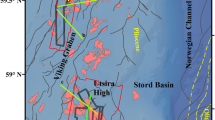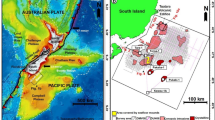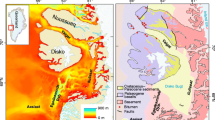Abstract
This study aimed to constrain the source area of fluids responsible for the formation of a pockmark field in the eastern Red Sea. The newly discovered field extends over an area of at least 1,000 km2 at a water depth of ~400 m. The pockmarks have modal diameters of 140–150 m and are either randomly distributed on the seafloor or aligned within valleys approximately 25 m deep and several kilometres in length. Seismic data show that chimneys and/or regions of acoustic turbidity prevail beneath the pockmark field down to the top of Miocene evaporites, which are widespread in the Red Sea. Four gravity cores were taken from the pockmark field. For most of the cores, geochemical analyses show that porewater has a higher Cl concentration than the local seawater and increased Cl/Br ratios, which indicate an origin from evaporites. The adsorbed hydrocarbons are of thermal origin, with C1/(C2+C3) ratios between 4 and 23 and stable carbon isotope data for methane varying from δ13C of –34 to –36.4‰ with respect to Vienna Pee Dee Belemnite. On the basis of the calculated maturity of the source rock of 1.2–1.4 Ro, local thermal gradients and sedimentation rates, its deeper depth boundary is approximated at 2,000 to 2,200 m. The results indicate that the adsorbed hydrocarbons sampled at the seafloor had to pass through an evaporite sequence of potentially several hundred metres to a few km in thickness. The most likely explanation for the increased permeability of the evaporite sequence is brittle deformation triggered by extensive local tectonic movements and supported by high fluid overpressure within the evaporite sequence.











Similar content being viewed by others
References
Abrams MA (1996) Interpretation of methane carbon isotopes extracted from surficial marine sediments for detection of subsurface hydrocarbons. In: Hydrocarbon migration and its near-surface expression. AAPG Memoir no 66, pp 309–318
Abrams M (2013) Best practices for the collection, analysis, and interpretation of seabed geochemical samples to evaluate subsurface hydrocarbon generation and entrapment. Offshore Technol Conf Proc 4:3109–3129. doi:10.4043/24219-MS
Augustin N, Devey CW, van der Zwan FM, Feldens P, Tominaga M, Bantan RA, Kwasnitschka T (2014) The rifting to spreading transition in the Red Sea. Earth Planet Sci Lett 395:217–230. doi:10.1016/j.epsl.2014.03.047
Barnard PC, Thompson S, Bastow MA, Ducreux C, Mathurin G (1992) Thermal maturity development and source-rock occurrence in the Red-Sea and Gulf of Aden. J Pet Geol 15:173–186. doi:10.1111/j.1747-5457.1992.tb00961.x
Batang ZB, Papathanassiou E, Al-Suwailem A, Smith C, Salomidi M, Petihakis G, Alikunhi NM, Smith L, Mallon F, Yapici T, Fayad N (2012) First discovery of a cold seep on the continental margin of the central Red Sea. J Mar Syst 94:247–253. doi:10.1016/j.jmarsys.2011.12.004
Bernard BB, Brooks JM, Sackett WM (1978) Light hydrocarbons in recent Texas continental shelf and slope sediments. J Geophys Res 83:4053. doi:10.1029/JC083iC08p04053
Berndt C (2005) Focused fluid flow in passive continental margins. Philos Trans R Soc A Math Phys Eng Sci 363:2855–2871. doi:10.1098/rsta.2005.1666
Beydoun ZR, Sikander AH (1992) The Red-Sea Gulf of Aden - reassessment of hydrocarbon potential. Mar Pet Geol 9:474–485
Biton E, Hildor H, Peltier WR (2008) Red Sea during the Last Glacial Maximum: implications for sea level reconstruction. Paleoceanography 23, PA1214. doi:10.1029/2007PA001431
Bosworth W (2015) Geological evolution of the Red Sea: historical background, review, and synthesis. In: Rasul N, Stewart I (eds) The Red Sea: the formation, morphology, oceanography and environment of a young ocean basin. Springer, Heidelberg, pp 45–78
Bosworth W, Huchon P, McClay K (2005) The Red Sea and Gulf of Aden Basins. J Afr Earth Sci 43:334–378. doi:10.1016/j.jafrearsci.2005.07.020
Bussmann I, Suess E (1998) Groundwater seepage in Eckernförde Bay (Western Baltic Sea): effect on methane and salinity distribution of the water column. Cont Shelf Res 18:1795–1806. doi:10.1016/S0278-4343(98)00058-2
Caress D, Chayes D (1995) New software for processing sidescan data from sidescan-capable multibeam sonars. Proc IEEE Ocean 95 Conf, pp 997–1000
Cathles LM, Su Z, Chen D (2010) The physics of gas chimney and pockmark formation, with implications for assessment of seafloor hazards and gas sequestration. Mar Pet Geol 27:82–91. doi:10.1016/j.marpetgeo.2009.09.010
Chand S, Rise L, Ottesen D, Dolan MFJ, Bellec V, Bøe R (2009) Pockmark-like depressions near the Goliat hydrocarbon field, Barents Sea: morphology and genesis. Mar Pet Geol 26:1035–1042. doi:10.1016/j.marpetgeo.2008.09.002
Cole GA, Abu-Ali MA, Coiling EL, Halpern HI, Carrigan WJ, Savage GR, Scolaro RJ, AI-Sharidi SH (1995) Petroleum geochemistry of the Midyan and Jaizan basins of the Red Sea, Saudi Arabia. Mar Pet Geol 12:597–614. doi:10.1016/0264-8172(95)98087-L
Crutchley GJ, Pecher IA, Gorman AR, Henrys SA, Greinert J (2010) Seismic imaging of gas conduits beneath seafloor seep sites in a shallow marine gas hydrate province, Hikurangi Margin, New Zealand. Mar Geol 272:114–126. doi:10.1016/j.margeo.2009.03.007
Davison I (2009) Faulting and fluid flow through salt. J Geol Soc Lond 166:205–216. doi:10.1144/0016-76492008-064
Davison I, Alsop I, Blundell D (1996) Salt tectonics: some aspects of deformation mechanics. Geol Soc Lond Spec Publ 100:1–10. doi:10.1144/GSL.SP.1996.100.01.01
Faber E, Stahl W (1983) Analytical procedure and results of an isotopic geochemical surface survey in an area of the British North Sea. In: Brooks J (ed) Petroleum geochemistry and exploration in Europe. Geological. Blackwell, London, pp 51–63
Faber E, Schmidt M, Feyzullayev A (2015) Light hydrocarbons in recent Texas continental shelf and slope sediments. Oil Gas Eur Mag 41:93–98
Feinstein S, Kohn BP, Steckler MS, Eyal M (1996) Thermal history of the eastern margin of the Gulf of Suez, I. Reconstruction from borehole temperature and organic maturity measurements. Tectonophysics 266:203–220. doi:10.1016/S0040-1951(96)00190-4
Feldens P, Mitchell N (2015) Salt flows in the Central Red Sea. In: Rasul N, Stewart I (eds) The Red Sea: the formation, morphology, oceanography and environment of a young ocean basin. Springer, Heidelberg, pp 205–218
Fleischer P, Orsi T, Richardson MD, Anderson A (2001) Distribution of free gas in marine sediments: a global overview. Geo-Mar Lett 21:103–122. doi:10.1007/s003670100072
Floodgate GD, Judd AG (1992) The origins of shallow gas. Cont Shelf Res 12:1145–1156. doi:10.1016/0278-4343(92)90075-U
Forwick M, Baeten N, Vorren T (2009) Pockmarks in Spitsbergen fjords. Nor J Geol 89:65–77
Friedman I, Hardcastle K (1974) Deuterium in interstitial waters from Red Sea Cores. In: Initial reports of the deep sea drilling project, 23. US Government Printing Office, pp 969–970. doi:10.2973/dsdp.proc.23.136.1974
Gay A, Lopez M, Berndt C, Séranne M (2007) Geological controls on focused fluid flow associated with seafloor seeps in the Lower Congo Basin. Mar Geol 244:68–92. doi:10.1016/j.margeo.2007.06.003
Gay A, Mourgues R, Berndt C, Bureau D, Planke S, Laurent D, Gautier S, Lauer C, Loggia D (2012) Anatomy of a fluid pipe in the Norway Basin: initiation, propagation and 3D shape. Mar Geol 332–334:75–88. doi:10.1016/j.margeo.2012.08.010
Girdler RW, Evans TR (1977) Red Sea heat flow. Geophys J Int 51:245–251
Girdler RW, Whitmarsh RB (1974) Miocene evaporites in Red Sea cores, their relevance to the problem of the width and age of oceanic crust beneath the Red Sea. In: Initial reports of the deep sea drilling project, 23. US Government Printing Office, Washington, pp 13–921. doi:10.2973/dsdp.proc.23.128.1974
Grunau HR (1987) A worldwide look at the cap-rock problem. J Pet Geol 10:245–265. doi:10.1111/j.1747-5457.1987.tb00945.x
Hart BS, Hamilton TS (1993) High-resolution acoustic mapping of shallow gas in unconsolidated sediments beneath the strait of Georgia, British Columbia. Geo-Mar Lett 13:49–55. doi:10.1007/BF01204392
Holness MB (1997) The structure of the halite-brine interface inferred from pressure and temperature variations of equilibrium dihedral angles in the halite-H2O-CO2 system. Geochim Cosmochim Acta 61:795–804
Hovland M, Rueslatten H, Johnsen H (2015) Red Sea salt formations – a result of hydrothermal processes. In: Rasul N, Stewart I (eds) The Red Sea: the formation, morphology, oceanography and environment of a young ocean basin. Springer, Heidelberg, pp 187–203
Judd AG (2003) The global importance and context of methane escape from the seabed. Geo-Mar Lett 23:147–154. doi:10.1007/s00367-003-0136-z
Judd AG, Hovland M (2009) Seabed fluid flow: the impact on geology, biology and the marine environment. Cambridge University Press, Cambridge
Karstens J, Berndt C (2015) Seismic chimneys in the Southern Viking Graben – implications for palaeo fluid migration and overpressure evolution. Earth Planet Sci Lett 412:88–100. doi:10.1016/j.epsl.2014.12.017
King L, MacLean B (1970) Pockmarks on the Scotian Shelf. Geol Soc Am Bull 81:3141–3148
Lawrence JR (1974) Stable oxygen and carbon isotopes variations in the pore waters, carbonates and silicates, sites 225 and 228, Red Sea. In: Initial reports of the deep sea drilling project, 23. US Government Printing Office, pp 939–942. doi:10.2973/dsdp.proc.23.130.1974
Lazar M, Lang G, Schattner U (2016) Coincidence or not? Interconnected gas/fluid migration and ocean–atmosphere oscillations in the Levant Basin. Geo-Mar Lett 36. doi:10.1007/s00367-016-0447-5
León R, Somoza L, Medialdea T, González FJ, Gimenez-Moreno CJ, Pérez-López R (2014) Pockmarks on either side of the Strait of Gibraltar: formation from overpressured shallow contourite gas reservoirs and internal wave action during the last glacial sea-level lowstand? Geo-Mar Lett 34:131–151. doi:10.1007/s00367-014-0358-2
Lewis S, Holness M (1996) Equilibrium halite-H2O dihedral angles: high rock-salt permeability in the shallow crust? Geology 24:431–434
Llewellyn GT (2014) Evidence and mechanisms for Appalachian Basin brine migration into shallow aquifers in NE Pennsylvania, USA. Hydrogeol J 22:1055–1066. doi:10.1007/s10040-014-1125-1
Magri F, Littke R, Rodon S, Bayer U, Urai J (2008) Temperature fields, petroleum maturation and fluid flow in the vicinity of salt domes. In: Littke R, Bayer U, Gajewski D, Nelskamp S (eds) Dynamics of complex sedimentary basins. The example of the central European basin system. Springer, Berlin, pp 277–290
Makris J, Tsironidis J, Richter H (1991) Heatflow density distribution in the Red Sea. Tectonophysics 198:383–393
Manheim FT, Waternamn LS, Woo CC, Sayles FL (1974) Interstitial water studies on small core samples, leg 23 (Red Sea). In: Initial reports of the deep sea drilling project, 23. US Government Printing Office, pp 955–967. doi:10.2973/dsdp.proc.23.135.1974
Mertineit M, Behlau J, Hammer J, Schramm M, Zulauf G (2012) Mechanical behavior of anhydrite rocks: results of field investigations, mineralogical-geochemical studies and thermomechanical experiments. In: Mechanical behaviour of salt, VII. Taylor & Francis, London, pp 123–129
Michaelis W, Jenisch A, Richnow HH (1990) Hydrothermal petroleum generation in Red Sea sediments from the Kebrit and Shaban deeps. Appl Geochem 5:103–114. doi:10.1016/0883-2927(90)90041-3
Mitchell D, Allen R, Salama W, Abouzakm A (1992) Tectonostratigraphic framework and hydrocarbon potential of the Red Sea. J Pet Geol 15:187–210
Mitchell NC, Ligi M, Ferrante V, Bonatti E, Rutter E (2010) Submarine salt flows in the central Red Sea. Geol Soc Am Bull 122:701–713. doi:10.1130/B26518.1
Mitchell NC, Schmidt M, Ligi M (2011) Comment on “Formation of Thetis Deep metal-rich sediments in the absence of brines, Red Sea” by Pierret et al. (2010). J Geochem Explor 108:112–113. doi:10.1016/j.gexplo.2010.09.014
Mitchell NC, Ligi M, Feldens P, Hübscher C (2015a) Deformation of a young salt giant: regional topography of the Red Sea Miocene evaporites. Basin Res. doi:10.1111/bre.12153
Mitchell NC, Ligi M, Rohling EJ (2015b) Red Sea isolation history suggested by Plio-Pleistocene seismic reflection sequences. Earth Planet Sci Lett 430:387–397. doi:10.1016/j.epsl.2015.08.037
Montgomery DR, Gillespie A (2005) Formation of Martian outflow channels by catastrophic dewatering of evaporite deposits. Geology 33:625–628. doi:10.1130/G21270.1
Orsi T, Werner F, Milkert D (1996) Environmental overview of Eckernförde Bay, northern Germany. Geo-Mar Lett 16:140–147
Orszag-Sperber F, Harwood G, Kendall A, Purser B (1998) A review of the evaporites of the Red Sea-Gulf of Suez rift. In: Purser B, Bosence D (eds) Sedimentation and tectonics in rift basins. Red Sea - Gulf of Aden. Springer, Berlin, pp 409–426
Pennino V, Sulli A, Caracausi A, Grassa F, Interbartolo F (2014) Fluid escape structures in the north Sicily continental margin. Mar Pet Geol 55:202–213. doi:10.1016/j.marpetgeo.2014.02.007
Pinet N, Duchesne M, Lavoie D, Bolduc A, Long B (2008) Surface and subsurface signatures of gas seepage in the St. Lawrence Estuary (Canada): significance to hydrocarbon exploration. Mar Pet Geol 25:271–288. doi:10.1016/j.marpetgeo.2007.07.011
Popp T, Kern H, Schulze O (2001) Evolution of dilatancy and permeability in rock salt during hydrostatic compaction and triaxial deformation. J Geophys Res 106:4061. doi:10.1029/2000JB900381
Presley B, Sims R, Feagley S (1974) Interstitial water chemistry DSDP Leg 23. In: Initial reports of the deep sea drilling project, 23. US Government Printing Office, Washington
Rao P, Madhavi T, Srinu D, Kalpana M, Patil D, Dayal A (2013) Geochemical assessment of light gaseous hydrocarbons in near-surface soils of Kutch–Saurashtra: implication for hydrocarbon prospects. J Earth Syst Sci 122:55–63
Rasul N, Stewart I, Nawab Z (2015) Introduction to the Red Sea: its origin, structure and environment. In: Rasul N, Stewart I (eds) The Red Sea: the formation, morphology, oceanography and environment of a young ocean basin. Springer, Heidelberg, pp 1–28
Ross DA, Schlee J (1973) Shallow structure and geologic development of the southern Red Sea. Geol Soc Am Bull 84:3827. doi:10.1130/0016-7606(1973)84<3827:SSAGDO>2.0.CO;2
Schenk C, Charpentier R, Klett T, Brownfield M, Kirschbaum M, Pitman J, Cook T, Tennyson M (2010) Assessment of undiscovered oil and gas resources of the Red Sea Basin Province. US Geol Surv Fact Sheet 2010-3119
Schléder Z, Urai JL, Nollet S, Hilgers C (2008) Solution-precipitation creep and fluid flow in halite: a case study of Zechstein (Z1) rocksalt from Neuhof salt mine (Germany). Int J Earth Sci 97:1045–1056. doi:10.1007/s00531-007-0275-y
Schmidt M, Hensen C, Mörz T, Müller C, Grevemeyer I, Wallmann K, Mau S, Kaul N (2005) Methane hydrate accumulation in “Mound 11” mud volcano, Costa Rica forearc. Mar Geol 216:83–100. doi:10.1016/j.margeo.2005.01.001
Schmidt M, Al-Farawati R, Al-Aidaroos A, Kürten B (2013) RV PELAGIA Fahrtbericht / Cruise Report 64PE350/64PE351 – JEDDAH-TRANSECT; 08.03. - 05.04.2012 Jeddah - Jeddah, 06.04 - 22.04.2012 Jeddah - Duba. GEOMAR, Kiel
Schmidt M, Al-Farawati R, Botz R (2015) Geochemical classification of brine-filled Red Sea deeps. In: Rasul N, Stewart I (eds) The Red Sea: the formation, morphology, oceanography and environment of a young ocean basin. Springer, Heidelberg, pp 219–233
Schmitt M, Thießen O (2003) A new designed sediment degassing system for small sample sizes to analyse free-, total-, and adsorbed gases. In: 7th Int Conf Gas Geochemistry (ICGG7), Freiberg/Sachsen
Schoenherr J, Urai JL, Kukla PA, Littke R, Schléder Z, Larroque J-M, Newall MJ, Al-Abry N, Al-Siyabi HA, Rawahi Z (2007) Limits to the sealing capacity of rock salt: a case study of the infra-Cambrian Ara Salt from the South Oman salt basin. Am Assoc Pet Geol Bull 91:1541–1557. doi:10.1306/06200706122
Schroot BM, Klaver GT, Schüttenhelm RTE (2005) Surface and subsurface expressions of gas seepage to the seabed—examples from the Southern North Sea. Mar Pet Geol 22:499–515. doi:10.1016/j.marpetgeo.2004.08.007
Seeberg-Elverfeldt J, Schlüter M, Feseker T, Kölling M (2005) Rhizon sampling of porewaters near the sediment-water interface of aquatic systems. Limnol Oceanogr Methods 3:361–371
Shishkina C (1978) Distribution of bromine, Cl/Br relationships and iodine in interstitial water of the Black Sea. DSDP Proc 42(2):631–635
Siddall M, Rohling EJ, Almogi-Labin A, Hemleben C, Meischner D, Schmeizer I, Smeed DA (2003) Sea-level fluctuations during the last glacial cycle. Nature 423:853–858
Simoneit BR, Grimalt JO, Hayes JM, Hartman H (1987) Low temperature hydrothermal maturation of organic matter in sediments from the Atlantis II Deep, Red Sea. Geochim Cosmochim Acta 51:879–894
Smith DB (1996) Deformation in the late Permian Boulby Halite (EZ3Na) in Teesside, NE England. Geol Soc Lond Spec Publ 100:77–87. doi:10.1144/GSL.SP.1996.100.01.07
Stewart SA (1999) Seismic interpretation of circular geological structures. Pet Geosci 5:273–285. doi:10.1144/petgeo.5.3.273
Sweeney JJ, Burnham AK (1990) Evaluation of a simple model of vitrinite reflectance based on chemical kinetics. Am Assoc Pet Geol Bull 74:1559–1570
Whiticar MJ (2002) Diagenetic relationships of methanogenesis, nutrients, acoustic turbidity, pockmarks and freshwater seepages in Eckernförde Bay. Mar Geol 182:29–53. doi:10.1016/S0025-3227(01)00227-4
Whiticar MJ, Faber E (1986) Methane oxidation in sediment and water column environments—isotope evidence. Org Geochem 10:759–768. doi:10.1016/S0146-6380(86)80013-4
Whitmarsh R, Weser O, Ross D (1974) Introduction. In: Initial reports of the deep sea drilling project, 23. US Government Printing Office, Washington. doi:10.2973/dsdp.proc.23.101.1974
Zhuo Q-G, Meng F-W, Song Y, Yang H-J, Li Y, Ni P (2014) Hydrocarbon migration through salt: evidence from Kelasu tectonic zone of Kuqa foreland basin in China. Carbonates Evaporites 29:291–297. doi:10.1007/s13146-013-0177-y
Acknowledgements
The efforts of the captains and crews of the research vessels Poseidon and Pelagia during our surveys is much appreciated. We wish to thank Neil Mitchell, Najeeb Rasul, Ian Stewart, the editors and reviewers for helpful comments. This work is the result of the Jeddah Transect Project, a collaboration between King Abdulaziz University and GEOMAR Helmholtz Center for Ocean Research that was funded by King Abdulaziz University (KAU) Jeddah, Saudi Arabia, under grant no. T-065/430. The authors acknowledge with thanks KAU technical and financial support.
Author information
Authors and Affiliations
Corresponding authors
Ethics declarations
Conflict of interest
The authors declare that there is no conflict of interest with third parties.
Rights and permissions
About this article
Cite this article
Feldens, P., Schmidt, M., Mücke, I. et al. Expelled subsalt fluids form a pockmark field in the eastern Red Sea. Geo-Mar Lett 36, 339–352 (2016). https://doi.org/10.1007/s00367-016-0451-9
Received:
Accepted:
Published:
Issue Date:
DOI: https://doi.org/10.1007/s00367-016-0451-9




